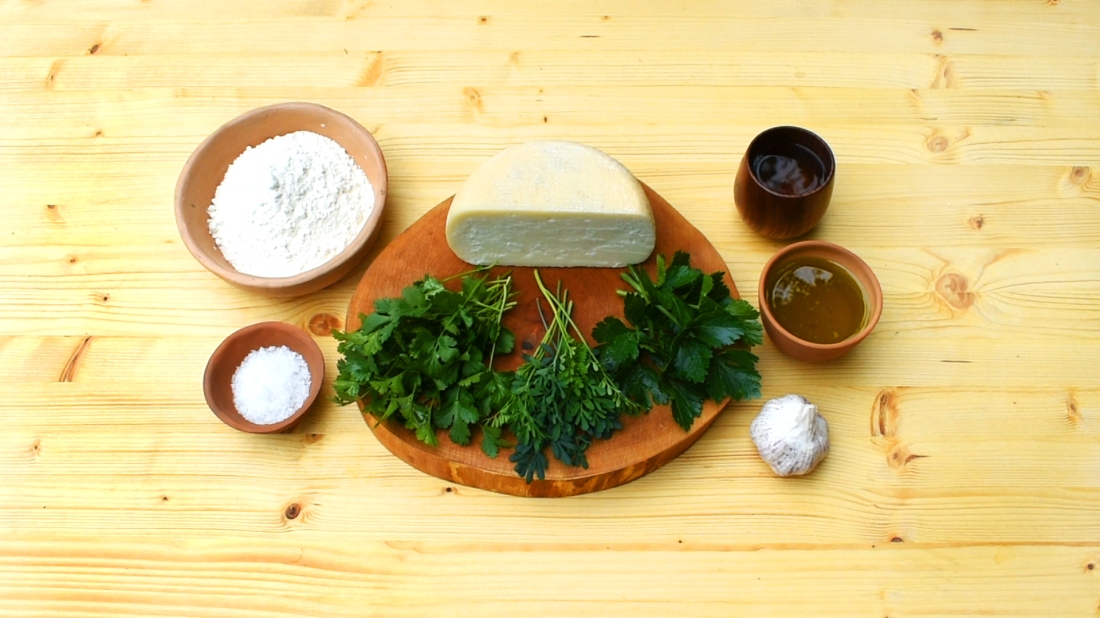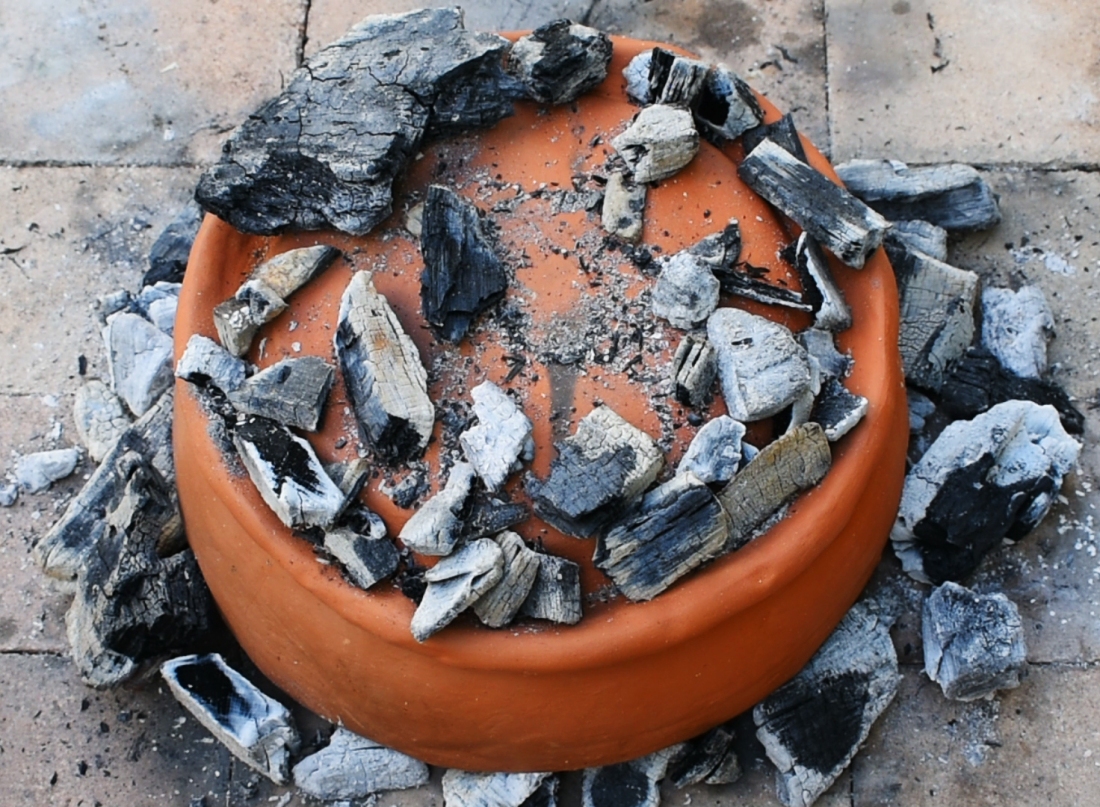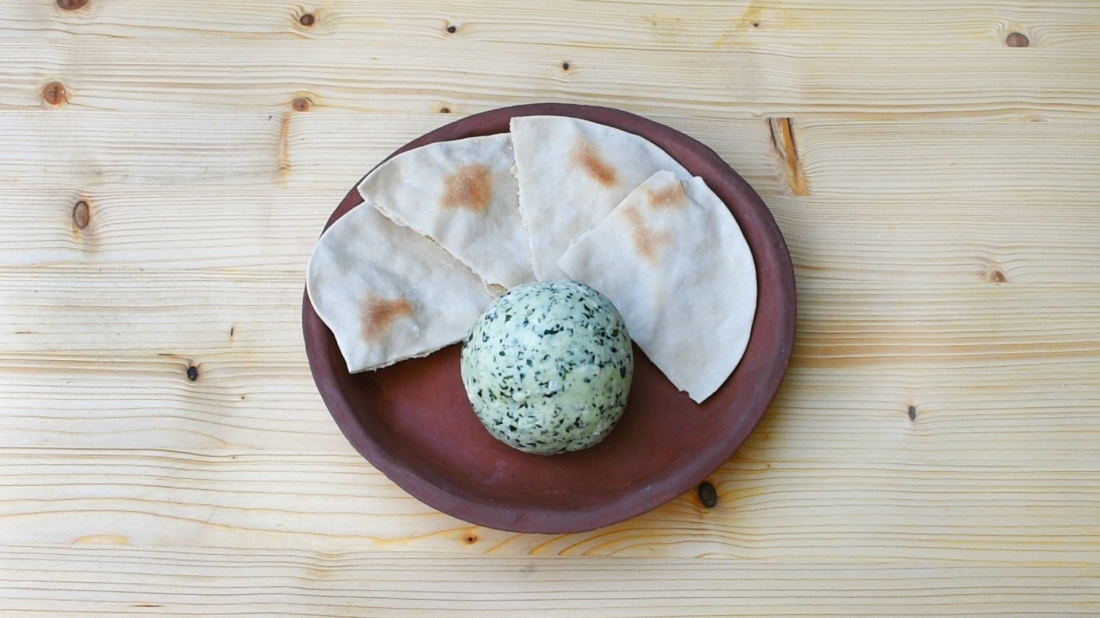Bread was a staple food in ancient Roman diet. We find information and recipes in authors like Pliny, Cato, Athenaeus, and others. Made with many kinds of cereals and legumes reduced to flour, it was prepared with or without yeast; sometimes milk, wine, extra virgin olive oil, must and other ingredients were added.
This recipe is particularly interesting, despite the simplicity of the white flatbread prepared, and not only because the method of cooking is peculiar of ancient Rome. The source, indeed, is not a cookbook or an agriculture handbook, but a poem once attributed to Virgil, Moretum (around the 1st century), collected into the Appendix Vergiliana. Other recipes of moretum survived, a common and simple meal prepared with cheese and aromatic herbs, fresh or dried.
This text shows the average day of a farmer and his diet, describing thoroughly the preparation of his modest meal: the flatbread with its filling, moretum, made with aged cheese, garlic, and fresh herbs from his garden.
We thought it was fascinating because the author presents a slice of the daily life of an ancient Roman farmer.
For cooking the flatbread, we used the testum. Testum was a terracotta cooking vessel characteristic of ancient cuisine, used by Romans but also during the Middle Ages and Renaissance as a sort of portable oven. It is difficult to buy one, so we made our own at home copying the archaeological artifacts. You can use instead a regular oven or a pan to cook the bread.
Below you will find a note about the ingredients and a comment about the original source. Enjoy your ancient Roman farmer’s meal!
If you want to know more about the use of cereals throughout history, read our book Early Italian Recipes. Cereals, bread, pasta, and pies, where you will find historical information about cereals and their preparations from the Antiquity to the end of the Renaissance, with 114 recipes for pasta, bread, pizza, pies, and more, newly translated and explained. For more information about ancient cuisine, read our book Ancient Roman Cooking. Ingredients, Recipes, Sources. Moreover, the full translation of De Re Coquinaria is available on Patreon, with further translations and articles on ancient and medieval cooking.
To learn about the transition between ancient and medieval cooking, check out our translation, commentary, and glossary of a beautiful 6th-century source, De Observatione Ciborum, written by the physician Anthimus to the king of the Franks Theuderic; if you are interested in late-medieval cuisine, we recommend Libro de la Cocina. Medieval Tuscan Recipes and Registrum Coquine. A medieval cookbook. If you are interested in recipes for vegetables from the Antiquity to the beginning of the Modern Era in Early Italian Recipes. Vegetables, fruit, herbs, and flowers available in English and Italian.
To support our work, you can buy us a beer or purchase our merchandise.
Ingredients
200 gr white wheat flour for three flatbreads
4 cloves of garlic
extra virgin olive oil
white wine vinegar
aged pecorino cheese
fresh herbs (rue, tender celery tops, cilantro)
sea salt
Method
First, prepare the flatbread. Mix the flour with a pinch of sea salt and warm water, kneading until the dough reaches a smooth consistency. Shape the bread into a thin disk using your hands or a rolling pin, then track the quarters with a knife without cutting through. Let the bread rest for a while.
For making the filling, pound in the mortar four cloves of garlic with a pinch of coarse sea salt, then add the cheese. Mince finely the herbs and then pound them with the other ingredients pouring few drops of extra virgin olive oil and a little vinegar. When the mixture reaches a smooth consistency, shape it into a ball with your hands.
Cook the flatbread under the testum, covering it with charcoal. When it is ready, serve the bread with the moretum.
Note about the ingredients
The author doesn’t specify the kind of cheese, just that it is aged. You can choose sheep, goat, or cow cheese.
The flour used is white wheat flour. In the text, the farmer, after grinding the wheat, sifts it to remove the bran.
The farmer of the poem uses four heads of garlic. We reduced this quantity according to our taste.
Rue is an aromatic herb recurring in ancient Roman cooking. It could be difficult to find, so we suggest growing it in your garden, as we do, or in a vase. If you don’t get rue, you can substitute it with other fresh herbs. Columella’s recipe for moretum includes savory, mint, lettuce, arugula, thyme, pennyroyal, and lesser calamint.
Appendix Vergiliana’s Moretum
The poem begins with Simulus waking up, saddened by the fear of a day of fasting. He is a farmer with a modest field (exigui cultor cum rusticus agri) who earns a living selling once a week the vegetables of his garden at the market. Suddenly he has an idea and collects from his pantry a little wheat lying on the floor. Singing rustic songs (rustica carmina) to alleviate the exertion, he mills the wheat with the millstone. When he has finished, he sifts the flour to remove the bran (transfert inde manu fusas in cribra farinas et quatit; ac remanent summo purgamina dorso). He puts the flour on the table and kneads it with warm water, sprinkling the dough from time to time with salt. Then, Simulus shapes a thin disk with his hands and tracks accurately the quarters (levi tum protinus illam componit tabula, tepidas super ingerit undas, contrahit admixtos nunc fontes atque farinas, transversat durata manu liquidoque coacta interdum grumos spargit sale. Iamque subactum levat opus palmisque suum dilatat in orbem et notat impressis aequo discrimine quadris).
Now, Simulus places the bread under the testum and covers it with charcoal (infert inde foco […] testisque tegit, super aggerat ignis).
While the bread is cooking, Simulus takes the aged cheese suspended over the fireplace and goes to his garden for gathering fresh herbs. First, he picks four heads of garlic with their roots, then young celery tops, rue, and cilantro (quattuor educit cum spissis alia fibris, inde comas apii graciles rutamque rigentem vellit et exiguo coriandra trementia filo).
After peeling the garlic, Simulus pound it in the mortar with salt, cheese, and herbs until the mixture becomes neither green, because of the presence of the cheese, nor milk-white for the herbs (summis spoliat coriis contemptaque passim spargit humi atque abicit […]; his salis inspargit micas, sale durus adeso caseus adicitur, dictas super ingerit herbas […]; paulatim singula vires deperdunt proprias, color est e pluribus unus, nec totus viridis, quia lactea frusta repugnant, nec de lacte nitens, quia tot variatur ab herbis).
Later, he adds a few drops of olive oil and a little vinegar (ergo Palladii guttas instillat olivi exiguique super vires infundit aceti), mixing all together. Now it is the time to shape it into a sphere with his hands: a perfect moretum.
Won the anxiety for the fasting, Simulus is ready for a day of work in the fields.
Here you will find the complete Latin poem.
Buy me a coffee
Patreon
Ancient Roman Recipes Playlist
Ancient Greek Recipes Playlist
Medieval Recipes Playlist
YouTube Channel
Merchandise
Books
Early Italian Recipes. Cereals, bread, pasta, and pies
Libro de la Cocina by Anonimo Toscano. Medieval Tuscan Recipes
Early Italian Recipes. Vegetables, fruit, herbs, and flowers
De Observatione Ciborum by Anthimus. Early-medieval recipes at the court of the Franks.
Registrum Coquine by Johannes Bockenheim. A medieval cookbook
Ancient Roman Cooking. Ingredients, Sources, Recipes
Translations of Historical Sources
De Agri Cultura by Cato – first part (2nd century BCE)
De Re Coquinaria by Apicius (Ancient Rome)
Apicii Excerpta by Vinidarius (5th or 6th century)
De Observatione Ciborum by Anthimus (6th century)
Appendicula de Condituris Variis by Johannes Damascenus (8th or 9th century)
De Flore Dietarum (11th century)
Tractatus de Modo Preparandi et Condiendi Omnia Cibaria (13th or 14th century)
Liber de Coquina – first part (14th century)
Enseignemenz (14th century)
Opusculum de Saporibus by Mainus de Maineris (14th century)
Libro de la Cocina by Anonimo Toscano (14th century)
Anonimo Veneziano (14th century)
Registrum Coquine by Johannes von Bockenheim (15th century)
Libro de Arte Coquinaria by Maestro Martino – parts 1-4 (15th century)
Recipes
Plebeian Mushrooms
Beef Skewers
Stuffed Chard
Shrimp
Frittata with Peas – Conchicla Commodiana
Tuna
Pork Stew with Red Wine
Chicken with Green Sauce
Pork Chops – Ofellae
Chicken with Dill – Pullus Anethatus
Religious Offering to Mars Silvanus
Rabbit
Gourds – Gustum de Cucurbitis
Roast Pheasant
Tyropatina – Honey Pudding
Pork Shank with Apician Sauce
The Diet of the Legionaries – Soup with Mutton and Beans
Chicken with Dill
Beef Roast with Quinces
Chard with Mustard
Religious Offering to Carna – Puls Fabacia
Pork Stuffed with Pasta – Porcellus Tractomelinus
Gilt-Head Sea Bream
Moretum – A Religious Offering to Cybele
Patina Versatilis
Aristophanes’ Roasted Birds
Pork Roast with Myrtle Berries
Cabbage Rolls
Pork Collar
Chicken with Taro
Honey and Millet Libum
Ham in Crust
Encytum
The diet of the ancient Germans
The diet of the Franks
Kandaulos
Wild Boar
Hypotrimma
Oysters and Clams
Peas
Ancient Sicilian Sea Bass
Pork Roast and Lentils with Sumac
Scampi
Cuttlefish and Eggs
Gustum de Praecoquis – Appetizer with Apricots
Octopus and Cucumber Salad
Copadia Agnina – Lamb Stew
Apothermum – Spelt Cakes
Pullus Parthicus – Roast Chicken
Tisana Barrica – Barley Soup
Beef Roast and Shallots
Staitites – Ancient Greek Sweet
Chicken Meatballs and Mashed Peas
Sweet Fritters – Dulcia Domestica
Columella’s Moretum and Hapalos Artos
Ancient Roman Frittata
A Saturnalia Recipe – Roast with Saffron Sauce
Muria – Ancestor of Colatura di Alici
Globi – Ancient Roman Sweet
The Diet of the Roman Legionaries – Buccellatum, Lardum, and Posca
How to make garum
Fig Sweet
Ancient Roman Gourd and Eggs
Ofella – Ancient Roman Steak
Fruit salads – Melon and Peaches
Isicia Marina – Shrimp Cakes and Cucumber Salad
Sala Cattabia – Snow and Posca
Copadia – Beef Stew
Puls Punica – Phoenician Dessert
Farcimina – Spelt and Meat Sausages
Ova Spongia ex Lacte – Sweet Omelettes
Flatbread and Chickpea Soup
Chicken stew
Salted Fish with Arugula Sauce
Savillum – Cheesecake
Pasta and Meatballs – Minutal Terentinum
Venison Stew with Spelt Puls
Veal with Allec Sauce – Ius in Elixam Allecatum
Isicia Omentata – Meatballs Wrapped in Caul Fat
Placenta – Honey Cheesecake
Pork Laureate – Porcellum Laureatum
Mashed Chestnuts
Poppy Seed Bread with Ancient Dry Yeast
Cured Olives and Epityrum


